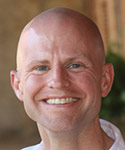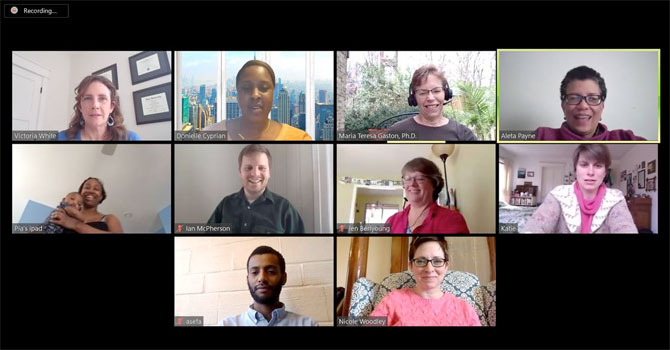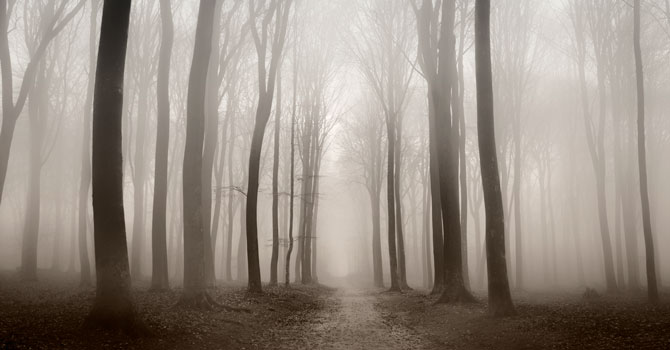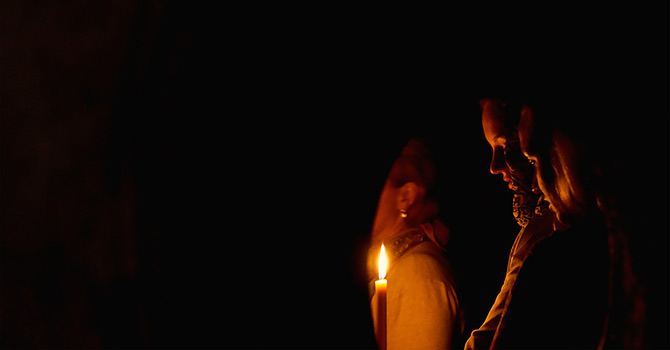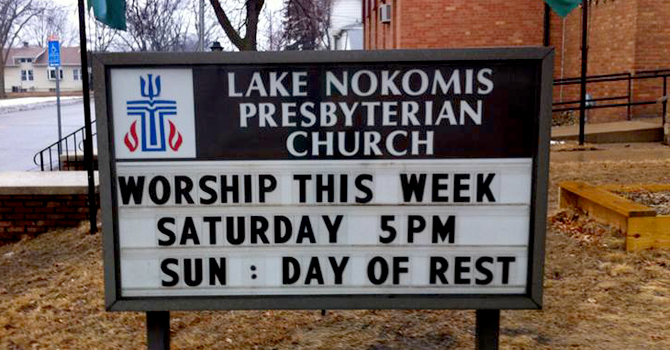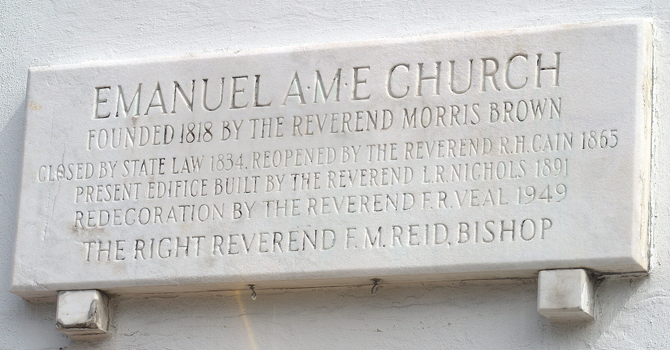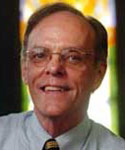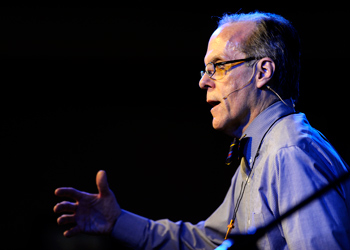Editor’s note: Faith & Leadership offers sermons that shed light on issues of Christian leadership.
I looked around the room. I was in the company of a few hundred other clergy, chaplains, hospice workers, funeral directors and mortuary school students -- all gathered to hear Tom Long and Thomas Lynch speak on “The Good Death, Good Grief, Good Funerals.”
Long, a theologian, and Lynch, a writer and undertaker, invited us to reflect with them on the shifts taking place in how Americans handle their dead. Not death -- the dead. Because, as they explained, the human species deals with the idea of death by dealing with the thing itself: the dead person. What we do with one who has died speaks volumes about how we understand death in our culture.
Throughout history, humans have recognized that the body of one who dies can no longer remain among the living. It must be moved in some way and to some resting place. This basic reality is a constant across all societies, and how it unfolds in any particular place or time is never perfunctory.
The basic metaphor, Lynch and Long suggested, is that a community accompanies a sacred person on a journey from the land of the living to the great mystery. We process the death by processing with the body from one place to another; in moving it, we are moved. (Picture, for instance, the processional of a presidential casket in Washington, D.C.)
This metaphor is in jeopardy, they contend, for a number of reasons: the breakdown of community, at least as it was understood in past centuries; the transience of our lives and scattered nature of our roots; the gradual erosion of our culture’s adherence to larger narratives, religious or otherwise sacred.
Honoring the dead seems to have less and less to do with their place within a community or narrative of shared beliefs and values and more to do with their individual hobbies and interests. “We used to bury Lutherans and Catholics,” Lynch noted. “Now we bury bowlers and golfers.” Call it secularism or whatever you want, but the growing absence of living by a sacred narrative, in a group and a story that transcends one’s own, can leave people at a loss to interpret the death of their loved ones.
It makes me think of the phone call I had recently from the mother whose infant died several months ago. I was the chaplain who performed the baptism. Her husband was Christian, and she herself had absolutely no religious background, but she was starting to think she wanted to have herself and her other children baptized, because she wanted to make sure they would all be together someday. “Do you know someone who could do that for me?” she asked.
I was struck by whatever was stirring deeply within her, but also compelled to have a bigger conversation about community, sacrament and so on, because her longings are about the here and now, not just about the hereafter.
There is no quick fix for healing anyone’s grief, but it was heart-wrenching to listen to someone who was aching for some language, some larger framework, some bigger story through which her grief might have meaning. Some of her child’s ashes are contained in a pendant on a necklace she wears, but her sorrow was uncontained when she asked me, “Will I see my child again?”
As our culture begins to divest itself of sacred narratives, Long said, we start doubting that the dead are really going anywhere, and we put our energy into venerating the next-best sacred story -- the biography of the deceased.
On top of this, our cultural aversion to aging and death leads us to favor practices that focus less on the death that has occurred and more on the task of helping the bereaved move on. More interested in therapeutic healing than in redemption or salvation, we work hard to celebrate the deceased’s life but leave little space to sit communally with the darkness of grief and loss.
The ages-old metaphor of moving the dead from one place and realm to another seems to be taking a back seat to the emerging metaphor in which we busy ourselves with moving as swiftly as possible from sorrow to stability. Perhaps, Lynch says, this is why bodies and remains are increasingly unwelcome at their own funerals; they impede the mourners’ trajectory toward stability.
The “sacred community theater,” as Long called it, in which we enact cultural scripts to move the dead in stages from the land of the living to their final resting place, is losing traction as we forgo the social customs that provide a script for the bereaved and that teach us why we do what we do when someone has died. The schedules and demands of the living do not yield to the dead as they used to. But it’s time, Lynch says, that we think about our obligations to the dead beyond just memorializing them.
What is at stake in addressing all this? What does it matter to society that we figure this out? It matters because a society that cares honorably and tenderly for the bodies of the dead is a society that can care honorably and tenderly for the bodies of the living.
When Long suggested this, I immediately thought of the funeral director who was sitting next to me, who volunteers his time and resources to help The Lazarus Program, a ministry of St. Anthony Shrine in downtown Boston committed to giving the homeless and destitute a dignified burial and resting place. Yes indeed, that ministry to the dead does speak volumes to a society that can be all too cavalier about what happens to the living bodies of the most vulnerable.
I thought, too, of my own gut reactions when I’ve heard staff at hospitals where I have worked call a chaplain because there’s an “expired patient.” It troubles me that the standard practice of our health care system leaves so little room to grapple with death.
It’s avoided either because we don’t have time for it or because it’s such an affront to the hubris of modern Western medicine. And though I can certainly empathize with the need to have emotional boundaries if one’s work with the very ill is to be sustainable, at the same time I can’t help but think that a healthier relationship to death could only enhance our capacity to carry out our service to the living with proper humility and gravitas.
Long and Lynch pointed out that we don’t go as far with our bodies as we used to. We’re less likely to even have them at the service, less likely to stay at the cemetery until the casket is lowered -- let alone pick up a shovel ourselves -- and almost entirely unlikely to actually go to a crematorium and witness the remains enter a final purification by fire.
I remember vividly an extreme example of this -- a woman I met in an emergency room whose husband, not yet dead two hours, had decided decades earlier to donate his body to the local medical school. “All right,” I explained, “ask the funeral home to bring his body there after whatever arrangements you have.” “No, no,” she said, “we’re not doing a viewing or a service or anything. No funeral home. Just have the medical school take him from here.” She motioned to the bag of clothes he had come in wearing, stating flatly that she’d be leaving those behind, too.
“We don’t really know how to deal with death, you know. You’re supposed to teach us how to do this,” she laughed nervously. “I bet you hear that all the time.” Her quick goodbye was not the norm, of course, but the impulse behind it probably wasn’t that foreign from what a lot of people enact when they, in one way or another, move swiftly to distance themselves from the physical realities of death, in the hopes that the “getting over it” process will also be swifter.
I think about the funeral director I worked with this past weekend when I conducted services for a very young child. “These situations are always the hardest for me,” he said. Understandably. For me, too. But then he went on to say that another one of the hardest parts of his work is when people want a cremation and nothing else -- no viewing, no service, no opportunity for people to come and say goodbye and simply be together in their loss.
It’s hard for him, he said, because he’s found that people tend to experience a sort of buyer’s remorse, wishing they had marked the death with something communal, something meaningful. “They can get stuck in their grief without it,” he said. “It’s hard for me to convince them on the front end, because people will think I’m just trying to sell them my services. But there’s a reason we do those things. People need that.”
All this leads me to consider how, undoubtedly, Christians are moved throughout Holy Week by moving with Christ through his final days. Isn’t that why we are drawn toward passion plays, stations of the cross, and the like?
We enact the story of the one who is approaching death, seeking to understand his death by mining the meaning in donkeys and palm branches, washing one another’s feet, breaking bread and sharing the cup, solemnly surveying the wondrous, horrific cross and waiting for the dawn of Easter morning to make sense of all of it.
Journeying with Jesus’ body, we see him inviting his followers to deal with death by dealing with the dead one. After all, Jesus eventually engages the questioning Thomas not with a dialogue on atonement theory but with a simple order: “Put your hands in my flesh.”
Consider too the significance of how and where we follow Christ’s body when all is said and done, whether we “go the distance” -- not theologically but viscerally. Most of our hymns, for instance, focus on the theological significance of the crucifixion and resurrection. One popular hymn that stands out starkly is “Were You There.” In simple and repetitive language, we witness the scenes that simply cause us to “tremble, tremble, tremble.”
Were you there
... when they crucified my Lord?
... when they nailed him to the tree?
... when they laid him in the tomb?
... when God raised him from the tomb?
The hymn is an African-American spiritual dating from at least the Civil War era, yet another song that gave spiritual voice to a people’s unspeakable pain and yearning for freedom and justice. The verses are a holy procession with Christ’s body -- words like “tree” no doubt summoning images of lynchings that its first hearers knew all too well. The two other verses in the oral tradition likewise evoke raw depictions of the violence and darkness of death: “Were you there when they pierced him in the side? Were you there when the sun refused to shine?”
It is no coincidence, I believe, that such a hymn arose out of the people in American history who understood most fully the horror of bodies beaten and bloodied, the unjust betrayal of the innocent with a sum of coins, and society’s skewed measure of a living body’s worth and a dead body’s worthlessness.
In the Gospel accounts, it is the women, Mary Magdalene and Jesus’ mother Mary, who do go the distance, staying with Jesus’ body long after the others have fled in the night, denied before daybreak or despaired at the cross. Is it any wonder, then, that the risen Christ first appears to these ones, to the long-suffering women who exposed themselves most fully to death’s objective presence, to the bitter reality of life without their beloved. It is they who will soonest behold death’s defeat and the triumph of new life.
Contemporary Christianity hasn’t done all that much to mine the meaning of Holy Saturday, perhaps because it doesn’t really have any “events” to enact, or perhaps because we don’t have a sense of what there is for believers to “get” out of it, as we “get” atonement from Good Friday, and “get” the promise of resurrection and life eternal from Easter.
Maybe we fear it would just be too depressing to really give Holy Saturday its due. Just revisiting the crucifixion itself leaves us sufficiently eager for Easter morning’s new verdict on death. And commercial culture would rather we skip over death and go right to new life altogether, plying us with eggs and chicks and bunnies and flowers before the snow has even melted enough to reveal the barrenness of the wintry terrain.
But there is a blessing to be gained, I think, in immersing ourselves in the reality of Holy Saturday -- that prolonged hyphen between the “already” and the “not yet.” It can affirm some of our life’s most wrenching experiences, the seasons that can feel interminable when we’re in their throes, waiting for the clutches of death to release their chokehold, dwelling in the shadows of what truly feels like a meaningless void.
It can shape us into deeper solidarity with so many in the world for whom much of life is experienced as a Holy Saturday, who wait for some light to appear in the midst of despair-inducing circumstances. It puts us more deeply in touch with the sheer urgency of our need for resurrection. Can we really comprehend or appreciate resurrection if we cannot stomach the full reality of death?
In the darkness of Saturday, we experience what fundamentally feels like God-forsakenness, while at the same time we wait in eager hope.
Saturday lends a sacredness to that bitter tension we are all too familiar with, to the agonizing waiting for some new creation when it truly feels like “it is finished.” It is the time during which God is at work on our wounds, transforming them like Christ’s from the mark of death’s claim into the scars that testify to death’s defeat and life’s triumph. It seems to me that many today are hungering for a narrative that gives Saturday its due before Easter arrives.
The narrative of Holy Week has something to offer to those who wander, having lost their way on the procession from life to death, too frightened to face the reality of death for fear that their intense grief may be purposeless or, worse yet, endless.
This Easter, may we proclaim anew, in word and in deed, that our lives are hidden with God in the one who was dead and buried and who has risen. The one who has gone before us on that fateful departure from the land of the living has blazed a new trail -- for our sake -- to new life in, with and through the living God.



